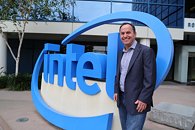- Joined
- Aug 19, 2017
- Messages
- 2,758 (1.01/day)
During Fortune's Brainstorm Tech conference in Aspen, Colorado, Intel's CEO Bob Swan took stage and talked about the company, about where Intel is now and where they are headed in the future and how the company plans to evolve. Particular focus was put on how Intel became "data centric" from "PC centric," and the struggles it encountered.
However, when asked about the demise of Moore's Law, Swan detailed the aggressiveness that they approached the challenge with. Instead of the regular two times improvement in transistor density every two years, Swan said that Intel has always targeted better and greater densities so that it would stay the leader in the business.

With 10 nm, Intel targets improved density by as much as 2.7x compared to the last generation of 14 nm transistors. He addressed the five year delay in delivering the 10 nm node being caused by "too aggressive innovation," adding that "... at a time it gets harder and harder, we set more aggressive goal..." and that's the main reason for the late delivery. Additionally he said that this time, Intel will stay at exactly 2x density improvements over two years with the company's 7 nm node, which is supposed to launch in two years and is already in development.
When talking about the future of Intel, Swan has noted that Intel's current market share is 30% of the "silicon market", saying that Intel is trying to diversify its current offerings from mainly CPUs and FPGAs to everything that requires big compute performance, in order to capture rest of the market. He noted that Artificial Intelligence is currently driving big demand for such performance, with autonomous vehicles expected to be a big source of revenue for Intel in the future. Through acquisitions like Mobileye, Intel plans to serve that market and increase the company's value.
You can listen to the talk here.
View at TechPowerUp Main Site
However, when asked about the demise of Moore's Law, Swan detailed the aggressiveness that they approached the challenge with. Instead of the regular two times improvement in transistor density every two years, Swan said that Intel has always targeted better and greater densities so that it would stay the leader in the business.

With 10 nm, Intel targets improved density by as much as 2.7x compared to the last generation of 14 nm transistors. He addressed the five year delay in delivering the 10 nm node being caused by "too aggressive innovation," adding that "... at a time it gets harder and harder, we set more aggressive goal..." and that's the main reason for the late delivery. Additionally he said that this time, Intel will stay at exactly 2x density improvements over two years with the company's 7 nm node, which is supposed to launch in two years and is already in development.
When talking about the future of Intel, Swan has noted that Intel's current market share is 30% of the "silicon market", saying that Intel is trying to diversify its current offerings from mainly CPUs and FPGAs to everything that requires big compute performance, in order to capture rest of the market. He noted that Artificial Intelligence is currently driving big demand for such performance, with autonomous vehicles expected to be a big source of revenue for Intel in the future. Through acquisitions like Mobileye, Intel plans to serve that market and increase the company's value.
You can listen to the talk here.
View at TechPowerUp Main Site




